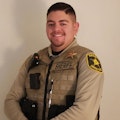Cold Case: Little Finger, Big Crime
I bring you this column out of my pure fascination with cold cases, forensics, police work, and all things mysterious. As an active duty Police Officer, I hold an interest in all cases especially those that bring justice to light in the end. The purpose of this column is to tell the story of how technology and forensics can play a key role in solving a case even if it has been cold for decades, giving hope to those who may be in the middle of a tough case that has led to sleepless nights. I have been there, and have experienced the constant thought process of how a case could be solved, questioning what is missing and going over the evidence numerous times. I hope you find these cases as intriguing and motivating as I do.
Cold Case Resolutions #5: Little Finger, Big Crime
Oversight. A word with two definitions, almost completely opposite one another. To oversee something means to have the authority or responsibility to ensure proper completion and accuracy, simply put, to look into something to make sure its done right. However, an oversight is the accidental omission of or failure to notice something. One word, standing both for care, and carelessness. For example an experienced detective may be in charge of oversight for a complex case to make sure there hasn't been any oversight by other investigators.
August 22nd, 1983, Malden, Massachusetts. 29 year old Rodney Wyman and a co-worker had traveled from Connecticut to install windows as part of a construction job. After a long day working in the near 100 degree heat, the men grabbed a bite to eat at a restaurant before returning to their room at the Town Line Motor Inn. Their rest didn't last long unfortunately, as at 10:46 PM they heard a noise coming from one of the bedrooms in the hotel. Wyman decided to check out the noise, but this decision would prove fatal. An armed man had climbed into the hotel room through a back window and flung the bedroom door open just as Wyman got close. The gunman fired a single shot, striking Wyman in the heart. Stunned by his injuries, Wyman staggered out of the room and collapsed in the parking lot, dead. Back inside the room the killer attacked Wyman's co-worker. The gunman beat the man and demanded to know where the money was. Knowing the gunshot likely attracted attention the attacker gave up his search for cash and decided to take valuables instead. He attempted to lift the television set, but this triggered a tamper alarm at the front desk. Two employees rushed to the hotel room and caught the man in the act. The gunman gave up on the television and fled out the window.
Massachusetts State Police arrived and detective's began processing the scene. After learning of the attempted theft of the television, the set was dusted for fingerprints. Latent prints were found on the underside of the television and were lifted, as well as various other prints from around the room which were determined to be unusable, or belonging to the victims and hotel staff. Police released a sketch of the offender but no suspects were charged. In 1986 the latent prints were entered into Massachusetts new Automated Fingerprint Identification System (AFIS), but no matches were found. After this the case would remain cold for 27 years.
In 2011 Massachusetts State Police decided to examine the evidence once again and placed Trooper Christopher Dolan in charge of comparing the fingerprints. Dolan Compared the prints to approximately 90 suspect fingerprint cards, and later entered the fingerprints into Massachusetts AFIS once again. His work would yield no results, but there was one more option. The fingerprints were entered into the much larger International Automated Fingerprint Identification System (IAFIS), and produced a match within minutes. The prints appeared to belong to a Massachusetts man named Shawn Marsh. With a suspect identified, Dolan was able to match three more fingerprints to Marsh. Marsh was taken into custody in September 2011 in relation to a separate and more prints were taken for comparison. These new fingerprint cards included palm prints, which were matched to a latent palm print taken from the motel room window. Marsh was charged with the murder of Rodney Wyman and in 2013 plead guilty to manslaughter after initially asserting his innocence. While Dolan and other investigators worked on the case they found Marsh's fingerprints were available in Massachusetts AFIS. Several months before the murder of Rodney Wyman, in April of 1983, Marsh was arrested and fingerprinted, and those print cards were later entered into AFIS. Thus they couldn't help but wonder why they didn't immediately get a match when Dolan entered the latent prints.
In the early days of AFIS storage space was limited. In order to save precious space, it was common practice to enter only eight fingers instead of ten, with the idea being every five sets of eight entered would save ten fingers worth of storage. The two fingers left out were the little fingers, as they were seen as the least likely to be used in the commission of a crime. In this case however, they were the most valuable piece of evidence available. This oversight was the block of ice upon which this case would go cold for nearly three decades, but thanks to additional oversight the murder was solved without additional delay.
About the Author

Officer Brendan Rodela, Contributing Editor
Brendan Rodela is a Sergeant for the Lincoln County (NM) Sheriff's Office. He holds a degree in Criminal Justice and is a certified instructor with specialized training in Domestic Violence and Interactions with Persons with Mental Impairments.
